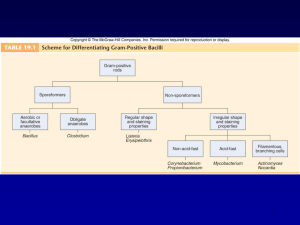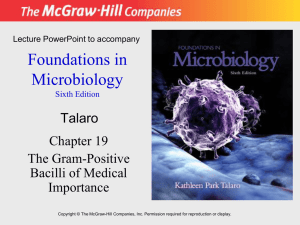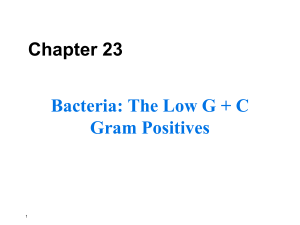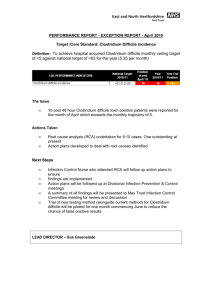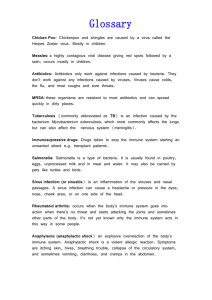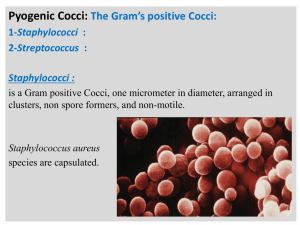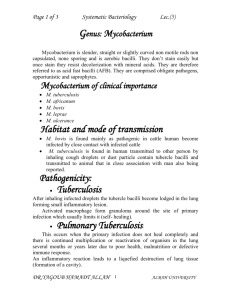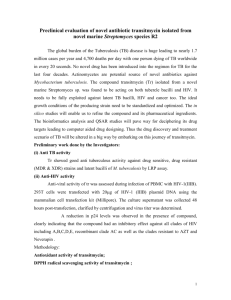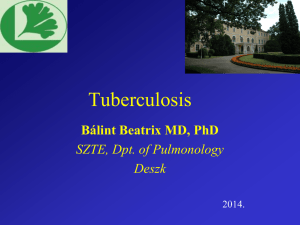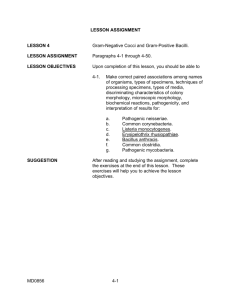CHAPTER 1 THE MAIN THEMES OF MICROBIOLOGY
advertisement
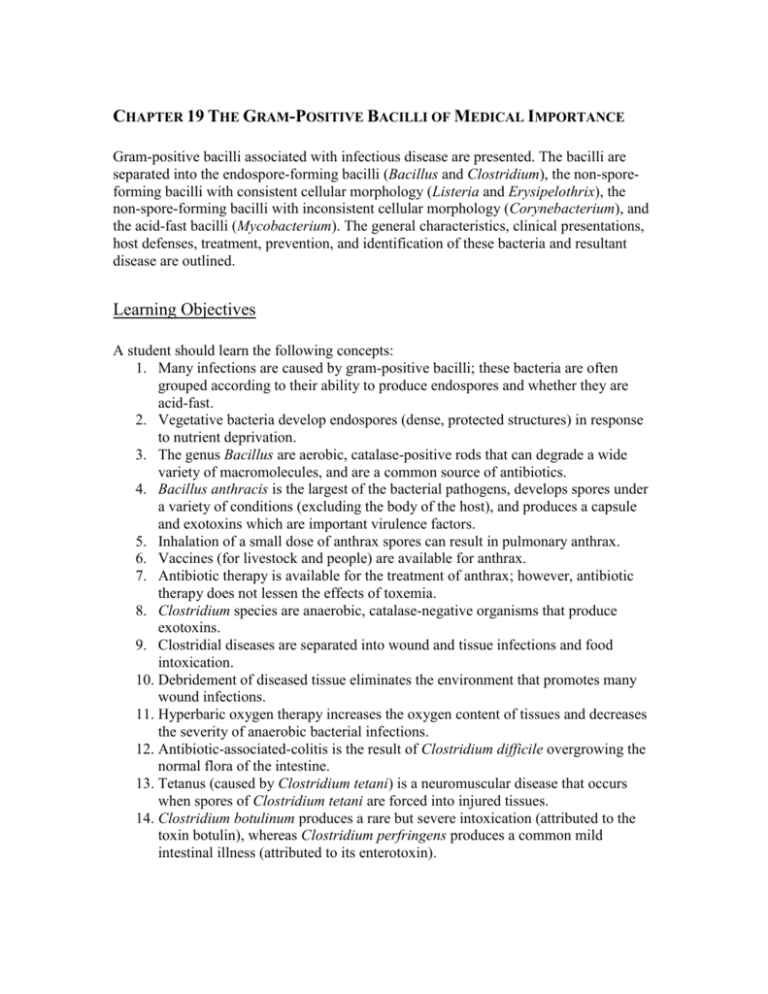
CHAPTER 19 THE GRAM-POSITIVE BACILLI OF MEDICAL IMPORTANCE Gram-positive bacilli associated with infectious disease are presented. The bacilli are separated into the endospore-forming bacilli (Bacillus and Clostridium), the non-sporeforming bacilli with consistent cellular morphology (Listeria and Erysipelothrix), the non-spore-forming bacilli with inconsistent cellular morphology (Corynebacterium), and the acid-fast bacilli (Mycobacterium). The general characteristics, clinical presentations, host defenses, treatment, prevention, and identification of these bacteria and resultant disease are outlined. Learning Objectives A student should learn the following concepts: 1. Many infections are caused by gram-positive bacilli; these bacteria are often grouped according to their ability to produce endospores and whether they are acid-fast. 2. Vegetative bacteria develop endospores (dense, protected structures) in response to nutrient deprivation. 3. The genus Bacillus are aerobic, catalase-positive rods that can degrade a wide variety of macromolecules, and are a common source of antibiotics. 4. Bacillus anthracis is the largest of the bacterial pathogens, develops spores under a variety of conditions (excluding the body of the host), and produces a capsule and exotoxins which are important virulence factors. 5. Inhalation of a small dose of anthrax spores can result in pulmonary anthrax. 6. Vaccines (for livestock and people) are available for anthrax. 7. Antibiotic therapy is available for the treatment of anthrax; however, antibiotic therapy does not lessen the effects of toxemia. 8. Clostridium species are anaerobic, catalase-negative organisms that produce exotoxins. 9. Clostridial diseases are separated into wound and tissue infections and food intoxication. 10. Debridement of diseased tissue eliminates the environment that promotes many wound infections. 11. Hyperbaric oxygen therapy increases the oxygen content of tissues and decreases the severity of anaerobic bacterial infections. 12. Antibiotic-associated-colitis is the result of Clostridium difficile overgrowing the normal flora of the intestine. 13. Tetanus (caused by Clostridium tetani) is a neuromuscular disease that occurs when spores of Clostridium tetani are forced into injured tissues. 14. Clostridium botulinum produces a rare but severe intoxication (attributed to the toxin botulin), whereas Clostridium perfringens produces a common mild intestinal illness (attributed to its enterotoxin). Chapter 19– Gram-Positive Bacilli of Medical Importance Page 2 of 7 15. The species Listeria monocytogenes is non-spore forming, has flagella (one to four), is facultatively anaerobic, and is resistant to cold, heat, salt, and pH extremes. 16. Corynebacterium diphtheriae are aerobic, irregular, non-spore forming bacteria which can cause upper respiratory tract or cutaneous infections (pathogenicity is associated with the production of diphtherotoxin). 17. Propionibacterium acnes grow in skin follicles and can stimulate inflammation and acne. 18. Mycobacterium species are aerobic, do not form capsules or spores, and have a complex layered structure with a high lipid content (contributing to making it impervious to many substances). 19. Mycobacterium tuberculosis does not produce exotoxins or enzymes, but produces complex waxes and cord factor that contribute to its virulence. 20. Only about 5% of people infected with tuberculosis develop a clinical case of TB. 21. Isolation of M. tuberculosis provides a unique challenge because specimens can become contaminated with rapid-growing bacteria that interfere with isolation of M. tuberculosis. 22. Mycobacterium leprae has not been grown in artificial media or human tissue cultures and has an extremely low rate of multiplication. 23. Actinomycetes are nonmotile, aerobic, and may be acid fast. 24. Actinomycosis is an endogenous infection by Actinomycetes living normally in the human. 25. Pulmonary nocardiosis is a form of bacterial pneumonia with pathology and symptoms similar to tuberculosis. 26. Nocardia brasiliensis causes pulmonary nocardiosis, especially in patients with deficient immunity. Chapter Outline (also see Chapter Summary with Key Terms p. 590) 19.1 Medically Important Gram-Positive Bacilli 19.2 Gram-Positive Spore-Forming Bacilli General Characteristics of the Genus Bacillus o Bacillus anthracis and Anthrax Introduction Cutaneous Anthrax Pulmonary Anthrax Methods of Anthrax Control Biothrax Penicillin, Tetracycline, or Ciprofloxacin o Other Bacillus Species Involved in Human Disease Bacillus cereus Food Poisoning The Genus Clostridium o The Role of Clostridia in Infection and Disease Chapter 19– Gram-Positive Bacilli of Medical Importance o o o o o Wound and Tissue Infections Food Intoxications Gas Gangrene/Myonecrosis Extent and Symptoms of Infection Treatment and Prevention of Gangrene Debridement Penicillin or Cefoxitin Hyperbaric Oxygen Therapy Clostridium difficile-Associated Disease (CDAD) Antibiotic-Associated (Pseudomembranous) Colitis Tetanus or Lockjaw The Course of Infection and Disease Tetanospasmin Toxin Risus sardonicus Treatment and Prevention of Tetanus Treatment o Human Tetanus Immunoglobulin o Penicillin or Tetracycline o Muscle Relaxants Prevention o DTaP Vaccine Clostridial Food Poisoning Epidemiology of Botulinum Food Poisoning Botulism The Route of Pathogenesis Botulin Toxin Infant and Wound Botulism Treatment and Prevention of Botulism Trivalent Horse Antitoxins Proper Food Handling and Preparation Clostridial Gastroenteritis Differential Diagnosis of Clostridial Species 19.3 Gram-Positive Regular Non-Spore-Forming Bacilli An Emerging Food-Borne Pathogen: Listeria monocytogenes o Epidemiology and Pathology of Listeriosis o Diagnosis and Control of Listeriosis Cold Enrichment Erysipelothrix rhusiopathiae: A Zoonotic Pathogen o Epidemiology, Pathogenesis, and Control Erysipeloid 19.4 Gram-Positive Irregular Non-Spore-Forming Bacilli Corynebacterium diphtheriae o Epidemiology of Diphtheria o Pathology of Diphtheria Page 3 of 7 Chapter 19– Gram-Positive Bacilli of Medical Importance Introduction Local Infection Toxin Production and Toxemia Diphtherotoxin and Toxemia Pseudomembrane Toxemia o Diagnostic Methods for Corynebacterium Alkaline Methylene Blue Stain Elek Test o Treatment and Prevention of Diphtheria Diphtheria Antitoxin DTaP Vaccine The Genus Propionibacterium o Propionibacterium acnes 19.5 Mycobacteria: Acid-Fast Bacilli Mycobacterium tuberculosis: The Tubercle Bacillus o Epidemiology and Transmission of Tuberculosis o The Course of Infection and Disease Initial Infection and Primary Tuberculosis Tubercles Caseous Lesions Tuberculin Reaction Latent and Recurrent Tuberculosis Extrapulmonary Tuberculosis o Clinical Methods of Detecting Tuberculosis Tuberculin Sensitivity and Testing Mantoux Test Induration Roentgenography and Tuberculosis Acid-Fast Staining Laboratory Cultivation and Diagnosis o Management and Prevention of Tuberculosis Mycobacterium leprae: The Leprosy Bacillus o Epidemiology and Transmission of Leprosy o The Course of Infection and Disease Tuberculoid Leprosy Lepromatous Leprosy o Diagnosing Leprosy o Treatment and Prevention of Leprosy Infections by Nontuberculous Mycobacteria (NTM) o Disseminated Mycobacterial Infections in AIDS o Nontuberculous Lung Disease o Miscellaneous Mycobacterial Infections 19.6 Actinomycetes: Filamentous Bacilli Page 4 of 7 Chapter 19– Gram-Positive Bacilli of Medical Importance Page 5 of 7 Actinomycosis o Actinomyces israelii Nocardiosis o Nocardia brasiliensis Student Activities 1. Have students design an educational campaign targeting individuals with TB disease. Ask students to address the following issues in this campaign: importance of the therapeutic regiment involving combined therapy, the importance of complying with drug protocols (still taking antibiotics even after you feel better), the risk of relapse with non-compliance, and the risk of bacteria developing multidrug resistance. 2. Ask students to investigate the natural reservoir(s) of Mycobacterium leprae. Divide the group into classes and have them investigate different topics: a. The possibility of an animal reservoir http://svm369.vetmed.lsu.edu/images/truman/Human%20and%20Armadil lo%20Leprosy.pdf, b. The possibility of an environmental reservoir http://medicine.plosjournals.org/perlserv?request=getdocument&doi=10.1371/journal.pmed.0020341, c. The origin of leprosy (comparative genomics traces all cases back to a single clone) http://www.sciencemag.org/cgi/content/short/308/5724/1040 and http://www.pubmedcentral.nih.gov/articlerender.fcgi?artid=1322279, d. And the geographic origin of leprosy http://www.nih.gov/news/pr/may2005/niaid-12.htm. e. Finally, have the students present their research to the rest of the class in a PowerPoint presentation. Classroom Discussion 1. Discuss the variety of antibiotics produced by Bacillus (polymyxin, difficidin, subtilin, mycobacillin, bacitracin, pumulin, laterosporin, zwittermicin, gramicidin, and tyrocidin). The range of activity of these antibiotics includes gram-positive bacteria, gram-negative bacteria, and fungi. Bacillus are saprobic and the precise role these antibiotics play in the growth and reproduction of Bacillus is unknown. Ask students what role they feel these antibiotics play. Current hypotheses involve possible competition between species, or regulation of sporulation and maintenance of dormancy. The following article Researchers Eye “Predatory” Bacterium for Novel Antimicrobial Strategies describes exploiting Bacillus to help identify new antibiotics: http://jama.amaassn.org/cgi/content/extract/291/10/1188. Chapter 19– Gram-Positive Bacilli of Medical Importance Page 6 of 7 2. Review with students the important role the portal of entry plays in any infection. Discuss the range in clinical presentations that can be seen with an anthrax infection on the skin (enters through cuts and abrasions) as opposed to in the lungs (inhalation of spores). Revisit Staphylococci and discuss the differences between an individual who carries Staph but displays no symptoms, and the result when Staph enters a wound. Remind students that infection is all about location, location, location. 3. Discuss with students the “perfect” habitat for Clostridium perfringens. This organism is adapted to surviving in conditions of low oxygen (the species Clostridium perfringens is considered anaerobic). During an infection it is the damaged or dead tissue that provides a suitable environment for gangrene. The decreased blood flow (due to the damaged or dead tissue) not only decreases the supply of oxygen to the site of the infection, but also decreases the chemotaxis of WBCs that are carried in the blood (immune cells can’t get to where the infection is). This organism has adapted to a very selective and specific niche, thus accounting for its success. 4. Discuss the risks of long-term antibiotic therapy not only in terms of development of resistant bacteria, but also in terms of the health of the host. Discuss antibioticassociated diarrhea. No pathogens are directly identified in antibiotic-associated diarrhea; the diarrhea is due to changes in the composition of the normal intestinal flora, most notably an overgrowth of C. difficile (http://www.clevelandclinicmeded.com/diseasemanagement/gastro/antibioticdiarr hea/antibioticdiarrhea.htm). This discussion should also revisit concepts presented in Chapter 13, Resident Flora: The Human as a Habitat (p. 383), and Indigenous Flora of Specific Regions (p. 385). 5. After presenting human tetanus immune globulin (TIG) (p. 572), ask students how they think TIG is prepared. Where does it come from? Then distribute the following information on BayTet (Tetanus Immune Globulin-Human) prepared from plasma of donors immunized with tetanus toxoid (http://www.talecrispi.info/inserts/BayTet.pdf). WHO recommendations for the production, control, and regulation of human plasma for fractionation is presented at this website: http://www.who.int/biologicals/publications/ECBS%202005%20Annex%204%20 Human%20Plasma%20Fractionation.pdf. Finally discuss the antitoxins available for C. botulinum. Ask students what kind of antitoxins they feel should be available and where they might come from. Discuss the currently available horse trivalent antitoxin. 6. Cord factor is briefly introduced (p. 580) as a virulence factor of mycobacteria. Discuss with students the fact that mycobacteria do not produce exotoxins or enzymes that destroy host tissue and contribute to infectiousness. Cord factor is a potent inhibitor of neutrophil migration and prevents bacterial destruction by macrophages, allowing mycobacteria to slip under the immune radar. Cord factor is most abundantly produced by the most virulent strains of Mycobacterium tuberculosis. 7. Introduce students to the concept of pathogenicity islands (PAIs). As the course begins to focus more on specific bacteria and the virulence factors associated with them, it is important for students to keep in mind the location of virulence factors Chapter 19– Gram-Positive Bacilli of Medical Importance Page 7 of 7 within the genome—and how these factors can be exchanged. The following article Ecological fitness, genomic islands and bacterial pathogenicity provides background on PAIs and discusses their role in pathogenicity: http://www.nature.com/embor/journal/v2/n5/full/embor418.html. 8. Ask students how a latent TB infection might become an active TB infection, and why (as discussed on p. 583) only 5% of people infected with TB develop a clinical case. Discuss with students some of the many factors that may contribute to a compromised immune system (age, stress, co-infection with HIV), and talk about how the bacteria might then escape from their encapsulated area and spread throughout the lung tissue. Applicable Online Quizzes www.mhhe.com/talaro7 A-B Exotoxins (Diphtheria Exotoxin) Chapter Quiz Key Terms and Phrases Bacillus anthracis anthrax cutaneous anthrax eschar pulmonary anthrax Bacillus cereus Clostridium exotoxins Clostridium perfringens gas gangrene myonecrosis debridement Clostridium difficile tetanus Clostridium tetani tetanospasmin Clostridium botulinum Clostridium perfringens botulism botulin regular listeriosis Erysipelothrix rhusiopathiae erysipeloid irregular Corynebacterium C. diptheriae diphtheria diphtherotoxin pseudomembrane toxemia Corynebacterium xerosis Propionibacterium P. acnes pilosebaceous Mycobacterium acid-fastness tubercle caseous lesion tuberculin reaction extrapulmonary TB mantoux test induration leprosy tuberculoid leprosy lepromatous leprosy actinomycosis nocardiosis N. brasiliensis cord factor Instructors are encouraged to visit the Foundations in Microbiology ARIS (Assessment, Review, Instruction System) site at www.mhhe.com/talaro7 for animations of key processes, online quizzing, case presentations, and more.
